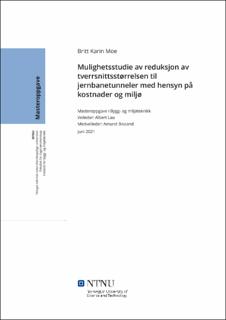| dc.contributor.advisor | Lau, Albert | |
| dc.contributor.advisor | Bruland, Amund | |
| dc.contributor.author | Moe, Britt Karin | |
| dc.date.accessioned | 2021-10-03T16:42:06Z | |
| dc.date.available | 2021-10-03T16:42:06Z | |
| dc.date.issued | 2021 | |
| dc.identifier | no.ntnu:inspera:80614265:15939521 | |
| dc.identifier.uri | https://hdl.handle.net/11250/2787276 | |
| dc.description.abstract | Det har vært en økning i tverrsnittsstørrelsene til jernbanetunneler i tråd med den
teknologiske utviklingen, fra de første togene begynte å kjøre på skinner i Norge.
Økningen i tverrsnittsstørrelsen kan forsvares med økt- og endret plassbehov i
tunneltverrsnittene, men det har vist seg å finnes svært lite litteratur og dokumentasjon
knyttet til prosjektering av tverrsnittsstørrelsen til jernbanetunneler. Det er
funnet at det for enkelte nyere prosjekter er prosjektert med større tverrsnittsstørrelse
for tunnelene enn det som er anbefalt i standarden. Derfor ble det funnet
nødvendig å undersøke hvor store tunneltverrsnittene behøver å være.
I prosjektet ble det foretatt målinger av tunneltverrsnittet på to tunneler på Gardermobanen,
som videre ble modellert og analysert med tanke på å undersøke om
det var mulig å redusere tverrsnittsstørrelsene. Disse tunneltverrsnittene ble videre
sammenlignet med tunneltverrsnitt fra nyere prosjekter, for å undersøke potensialet
for tverrsnittsreduksjon i henhold til dagens standard. Videre ble en beregningsmodell
for kostnader og CO2-utslipp fra byggefasen etablert, for å undersøke
hvilken effekt tverrsnittsreduksjon hadde på kostnader og CO2-utslipp fra byggefasen,
og hvor data fra analysen av tverrsnitt ble anvendt som inngangsparametere.
Det ble funnet at sonen for evakuering, sonen for faste installasjoner og sporkonstruksjonen
var områdene i tunneltverrsnittet med mest potensiale for reduksjon.
Reduksjonspotensialet til evakuerings- og rømningssonen kom fra muligheten til å
kombinere disse til en sone. Det ble videre funnet at ballastfritt spor som sporkonstruksjon
gir et slankere tunneltverrsnitt. Ved å gjennomføre reduksjon på disse
områdene ble det funnet et reduksjonspotensiale for tunneltverrsnittene i størrelsesorden
10m2. Dette gir følgelig en reduksjon av drivekostnader i størrelsesorden
4000 kr/m, reduksjon i CO2-utslipp på 500 kg CO2 pr enhetslengde og en reduksjon
i avgifter knyttet til CO2-utslipp på 900 kr pr enhetslengde. Gjennom prosjektet ble
det funnet at dagens prosjekteringsmetoder i liten grad er egnet for optimalisering
av tunneltverrsnitt, i lys av hvor stort reduksjonspotensiale som ble avdekket i
prosjektet, i tillegg til flere faktorer knyttet til kompleksiteten av jernbanetunneler,
som gjør prosjektering utfordrende. | |
| dc.description.abstract | There has been an increase in the cross section size of railway tunnels in line with
the technological development the past 100 years, from when the first trains started
to run on rails in Norway. The increase in the cross section size can be explained
by increased- and changed space requirements in the tunnel cross section, but it
has been limited literature and documentation on the subject of design and engineering
of railway tunnels. It was shown from some newer projects, that the
projects have designed the cross section larger than the requirements of the technical
standards. Therefore it has been found necessary to investigate how big the
cross section of railway tunnels are required to be.
Measurements of the cross section size of two tunnels on the Gardermoen-line was
obtained, which were further modelled and analysed in regards to investigating
if it were possible to reduce the cross sections. These cross sections were further
compared with cross sections from newer projects to investigate the reduction potential
in relation to today’s technical standards. A simplified computational model
for cost and CO2-emission from the building phase was established to investigate
the effect of cross section reduction on the cost and CO2-emissions, where the data
from the analysis of the cross sections were used as input parameters.
It was found that the area for evacuation, fixed installations and the track construction
were the areas within the cross sections with the highest reduction potential.
The reduction potential for the evacuation- and the installation area came from
the possibility of combining the areas. It was further found that ballast-less track
as the track structure can result in a smaller cross section. By conducting a reduction
in these areas, it was found that the reduction potential for the cross sections
was in the magnitude of 10m2. This gave a reduction in the construction cost in
the magnitude of 4000 NOK/m, a reduction in the CO2-emissions of 500 kg CO2
pr unit length, and a reduction in the costs related to the CO2-emissions of 900
NOK pr unit length. Through the project, it was found that today’s designing method
in little degree is suitable for optimization of tunnel cross section size, in light
of the great reduction potential found in the project. In addition to this, several
factors related to the complexity of railway tunnels also makes the design process
challenging. | |
| dc.language | nob | |
| dc.publisher | NTNU | |
| dc.title | Mulighetsstudie av reduksjon av
tverrsnittsstørrelsen til
jernbanetunneler med hensyn på
kostnader og miljø | |
| dc.type | Master thesis | |
